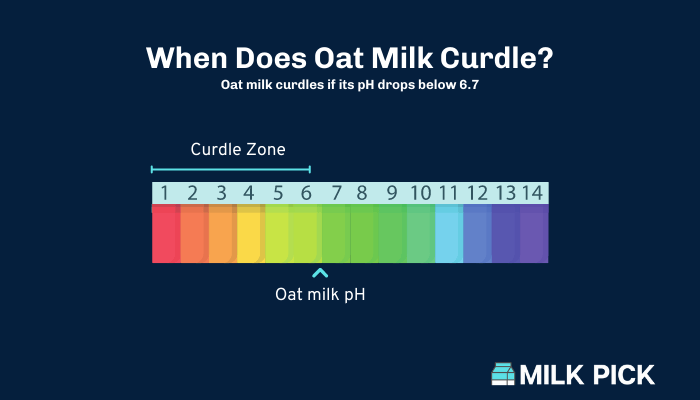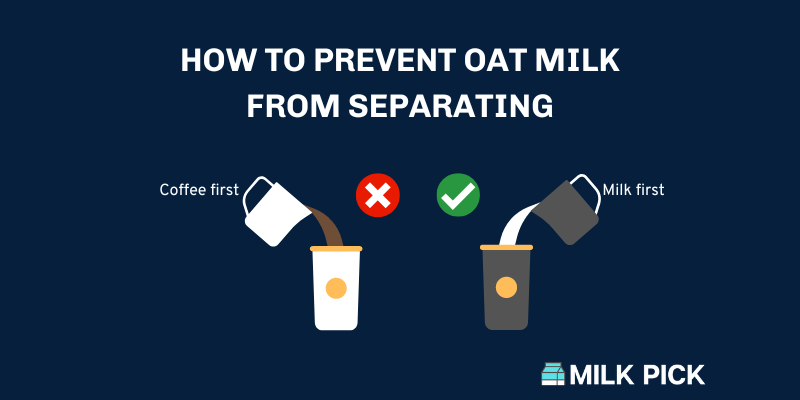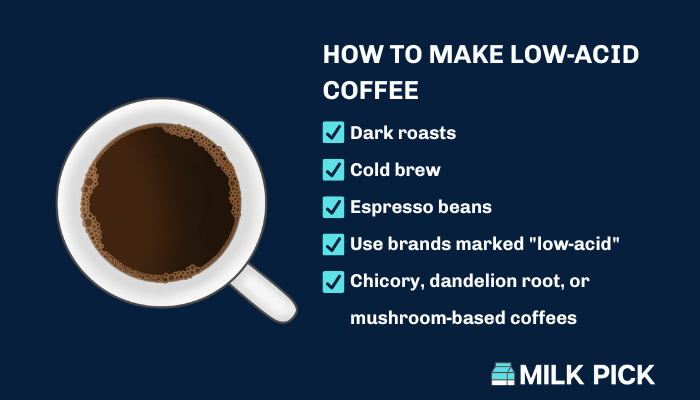Switching to a plant-based diet means substituting dairy-free milk in your daily coffee, tea, or recipes.
Oat milk is one of the most popular cow milk alternatives, with sales expected to grow to nearly $700 million by 2027.
If you opt for oat milk over other plant-based milk, you may notice that it separates when used in hot liquids like coffee or tea.
Oat milk separates due to the heat and acidity in some drinks. In some cases, oat milk separates due to poor emulsification.
Discover why oat milk separates and how you can prevent separation when using oat milk in your plant-based meals or drinks.
[lasso ref="amzn-willas-unsweetened-organic-oat-milk-32-oz-6-pack-low-sugar-1g-vegan-plant-based-non-gmo-shelf-stable-made-from-whole-grain-oats" id="7234" link_id="14778"]
Why Does Oat Milk Separate?
The reason oat milk separates primarily has to do with how it's made.
How Is Oat Milk Made?
Oat milk is created by soaking whole oats in water, then blending the mixture.
As the blender breaks down the oats, it produces smaller and smaller oat particles that become suspended in the water.
Once combined, the manufacturer (or you if you're making it at home!) strains out any oat pulp that remains, leaving behind a creamy, off-white beverage.
Oat milk sometimes separates because the oat particles are heavier than water. If left untouched, these particles eventually separate and sink to the bottom of the container.
Separation is more apt to occur with homemade oat milk or manufactured oat milk that uses simple ingredients and processing.
Some store-bought oat milk brands contain added ingredients to avoid this problem by using added ingredients or processes to emulsify the beverage.
What is Emulsification and What Does It Have To Do With Oat Milk Separation?
Emulsification refers to combining two substances, like oil and water, into a suspension.
Typically emulsion happens in regards to two liquids, but in the case of oat milk, the same concept applies.
For a liquid emulsion to occur, the particles of each substance must be broken down into equally small parts so that each stays suspended, creating a creamy, stable liquid.
If the particles don’t stay suspended on their own, you can use an emulsifier to create the emulsion.
An emulsifier coats the particles of the mixture, allowing them to keep separate and suspended rather than clumping together and separating.
Emulsifiers used in oat milk include sunflower oil, gums, carrageenan, and dipotassium phosphate.
We recommend avoiding emulsifiers when possible however. Many have been shown to cause gut health problems, inflammation and other negative conditions. Watch this video from Dr. Ann Wellness for more information.
Is Separation Different from Curdling?
You may notice your oat milk reacting slightly differently from separation, called curdling.
Rather than separating particles, curdling refers to a process in which oat milk gets clumpy.
The two look similar, but curdling is primarily due to the oat milk’s reaction to acidity or heat.
Oat milk has a pH of around 6.7 to 6.9; if the acidity increases, it will curdle.
This is similar to dairy milk, which curdles when lactic acid forms.
When you place oat milk in an acidic environment, such as a cup of coffee, it can cause it to circle.
Additionally, heating oat milk to higher than 70 degrees can cause it to curdle.
High temperatures speed up the curdling reaction and break down the oat milk faster, which can also cause it to separate.

Does Separated Oat Milk Indicate Spoilage?
No, separated oat milk doesn't necessarily indicate spoilage. Spoilage occurs when pathogens begin to grow in the oat milk.
It typically causes the oat milk to smell “off” or sour.
It may also cause the package to bulge or leak and generally occurs when you've had an open container of oat milk longer than 7 to 10 days or left it out for longer than 2 hours without refrigeration.
Although spoiled oat milk can separate or curdle, separation doesn’t indicate spoilage if the oat milk doesn’t show signs of bacteria or mold and isn't expired or left out in unsafe conditions (e.g. not refrigerated).
Related: How Long Does Oat Milk Last?
How Can You Stop Oat Milk From Separating?
If you're someone who loves using oat milk in your coffee or tea, you have a few options for preventing separation or curdling.
Try one of the following ideas to discover which works best for your needs:
[lasso ref="amzn-willas-unsweetened-organic-oat-milk-32-oz-6-pack-low-sugar-1g-vegan-plant-based-non-gmo-shelf-stable-made-from-whole-grain-oats" id="7234" link_id="14779"]
Avoid Mixing in Hot Beverages
One option you may have is to avoid mixing oat milk into your hot beverages altogether.
Perhaps you’ve tried another solution or don’t want to mess with curdled oat milk anymore. If that’s the case, you can stop using it in drinks like hot tea or coffee.
Instead of these beverages, you might try iced tea or coffee, which should work well with cold oat milk and allow you to enjoy the flavors you love without separating.
Warm the Oat Milk Before Adding It To Your Coffee
Because oat milk separates in coffee due to the heat, you can address the issue by warming up your oat milk before adding it to your morning tea or coffee.
While you don’t want to leave oat milk out for over 2 hours, you can pour a small amount that you’ll be using in your beverage and let it sit at room temperature for about 20 minutes before you use it.
Alternatively, you can place it in a warmed glass measuring cup, mug, or another holder so that it gently raises the temperature.
This can help the oat milk warm up slowly so it doesn’t cause curdling and prevent separation due to temperature extremes (i.e., refrigerated oat milk into hot liquid) when added to your coffee.
Related: Can You Heat Up Oat Milk?
Put the Oat Milk in First
If you don’t want to warm up the oat milk before you make your drink, you can take another approach called tempering.
In this case, tempering refers to equalizing the temperature of two ingredients so that one’s heat does not overpower the other and change its structure.
One example of this process is used during ice cream making.
Depending on the recipe, some custard or ice creams require you to combine a cream and milk mixture with egg yolks.
However, you must carefully temper the egg yolk mixture with the hot milk and cream mixture by adding a little bit in at a time of the hot mixture at a time and stirring it into the cooler substance, thereby raising the egg mixture’s temperature and avoiding cooking the yolks.
You can use the same technique for coffee and oat milk!
Rather than start with a full cup of hot coffee, put your oat milk in the mug first. Then, little by little, pour in a bit of your coffee and stir it in between if you wish.
This should slowly raise the oat milk’s temperature, so it doesn’t curdle or separate as the hot liquid fills the cup.

Try Coffee With a Lower Acidity
The acidity in your coffee may be causing your oat milk to separate or curdle.
Coffee made with Arabica beans and light-roast coffees are the highest in acidity, so if you drink these types of brews, you may experience a higher rate of curdling in your oat milk than if you drink a coffee with a lesser acidity level.
Try a low-acid option like the following to see if it solves your separation issue:
- Dark roast coffees - contain fewer acid-producing compounds
- Cold brew - less acidic due to 12 to 24-hour steep time and cooler temperatures
- Espresso beans - shorter brewing time which means less acid in your mug
- Coffee brands marked as low-acid
- Chicory, dandelion root, or mushroom-based coffees
In addition to using lower-acid coffees, you can opt for paper filters over metal ones.
The paper traps more acid as your coffee brews, leaving less in your cup to react with your oat milk.

Use a Barista Oat Milk
A super simple solution to an oat milk separation or curdling problem is to switch to barista oat milk.
Barista oat milk is made by several top brands specifically for baristas who make coffee and tea drinks like lattes, cappuccinos, and frappuccinos.
These oat milk options also behave like dairy milk because they froth easily and can withstand higher temperatures and acidity.
Most barista oat milk contains extra ingredients like oils or proteins to create stable oat milk that doesn’t separate or curdle when mixed into a hot drink.
For example, Elmhurst 1925 Barista Oat Milk uses disodium phosphate, an artificial salt additive and emulsifier, to ensure its barista blend acts like dairy milk and holds up to coffee and tea temperatures.
[lasso ref="amzn-willas-organic-barista-oat-milk-32-oz-6-pack-steams-froths-uses-maple-sugar-low-sugar-3g-vegan-plant-based-non-gmo-shelf-stable-made-from-whole-grain-oats" id="7231" link_id="14780"]
Emulsify Your Homemade Oat Milk
If you make your oat milk at home, you can keep it from separating by ensuring emulsion happens during the creation process.
You can invest in a high-speed blender that breaks down the oat particles as small as possible and moves the water and oats quickly to create a stable emulsion.
You can also add an emulsifier like lecithin powder or oil like avocado or coconut to help the mixture stay creamy and emulsified.
While you can also buy disodium phosphate to create barista-like oat milk at home, we suggest sticking with more natural ingredients like avocado or coconut oil.
Avoid Oat Milk Separation With Low Heat, Low Acidity, and the Right Brand
Using the proper techniques and brand of oat milk can more easily avoid separation or curdling.
Store-bought barista brands are your best bet for using hot coffee and tea. However, you can also use regular or homemade oat milk if you store it at the right temperature, temper it before putting it into your hot drink, and use low-acidity coffee to avoid curdling.
